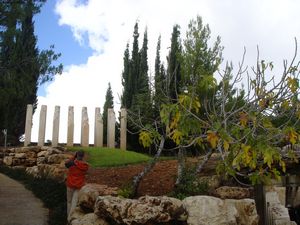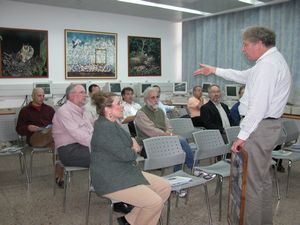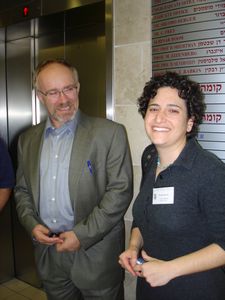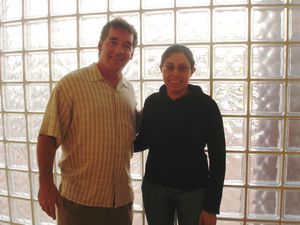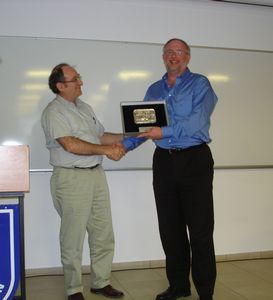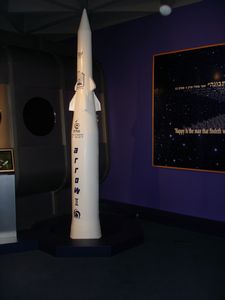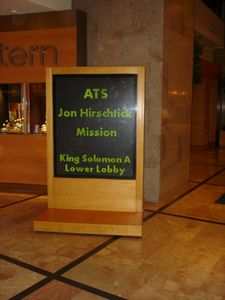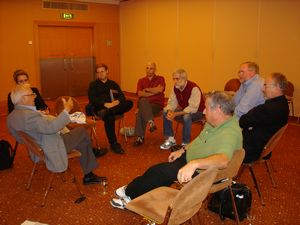This page documents the 2005 ATS Jon Hirschtick Mission to the Technion, 5-11 November. There are several related pages:
Click on any image to enlarge.
The mission of the mission was to bring together current and potential
Technion supporters to experience Jon's high tech version of Technion
and Israel. Members of the mission were invited by Jon from around
the world, generally from high tech, all successful in business, with
a strong SolidWorks representation. Jon and ATS were quite clear that
no contribution or other quid pro quo was expected.
Sunday, 6 November 2005
Most of the group arrived on Sunday night in Jerusalem. Linda's and
Steve's bags were lost, and they caught up with us one and two days
later while we were still in Jerusalem. We stayed at the David
Citadel Hotel for two nights (Sunday and Monday nights). It was
excellent and near the Old City.
Our tour was very well organized by Da'at Travel. Gilad Peled was
our tour guide, and our driver was Moshe. Born in Jerusalem, Gilad
could call himself a Palestinian, but Jews with local family lines
don't generally identify themselves as such. He was extremely
knowledgeable, and he oozed hospitality.
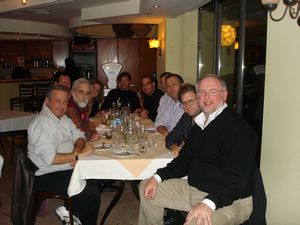 On Sunday night, we went to dinner at the Olive & Fish in
Jerusalem. We met Isaac Cohen and his friend Perez, both Technion
grads and both formerly Rafael employees. Although Technion is
Israel's engineering and science powerhouse, Yeshiva U and Tel-Aviv U
were described as up and coming.
On Sunday night, we went to dinner at the Olive & Fish in
Jerusalem. We met Isaac Cohen and his friend Perez, both Technion
grads and both formerly Rafael employees. Although Technion is
Israel's engineering and science powerhouse, Yeshiva U and Tel-Aviv U
were described as up and coming.
Reuven Hazan is a Senior Lecturer at the Hebrew University
Political Science Department and a commentator on NPR, etc. A ninth
generation Israeli, Hazan offered a succinct analysis of current
politics in Israel: the government may fall and a center coalition may
form, mitigating the power of extreme left and right. Sharon
demonstrated that a Labor crossover can work, similar to Begin making
Sinai agreements with Sadat.
For the US to be effective at its Iraqi mission and for the near
term success of the various regional activities moving in the
democratic direction, the US needs to stay long enough for democracy
to work, which is probably ten to fifteen years. It is unlikely the US
will stay that long (more likely a year or two); a power vacuum will
be formed, and Iran, which is the real center for terrorism, will
likely fill the void.
Can Israel exert control after disengagement? Yes. If they
(Palestinians) attack us (Israel) when we're out, we can strike
back. Conversely, the US cannot attack Iraq while occupying.
Disengagement was described as a demographic imperative. The
Palestinian population recently reached over 50% in "greater Israel."
Hamas has a political arm that realized there was a demographic method
to a one state (Palestinian) solution. By simply getting Israel to
accept all Palestinians as citizens, Palestinians will control any
democratic government by having more votes. The only way to maintain a
democratic and Jewish state is for Jews to remain in the
majority. Paul, Gilad, and I all expressed some concern for this sort
of reasoning, but seeing Palestinians as a "demographic problem" was a
recurring theme.
Yad Vashem, the Holocaust Memorial, was our first cultural stop. The
new museum opened earlier this year, and we also saw the Children's
Memorial (photo to the left). The consensus is that the new museum was created due to
competition from the museum in Washington D.C.
Generic stories, and stories of specific individuals are
told. Personal artifacts are preserved and placed in context. Nations
that acted humanely are honored. A research library of victims is
there. Yad Vashem is a powerful experience: it takes ones breath away.
We toured the Knesset, which houses Israel's parliament, and we had
the opportunity to meet with Haim Ramon, a senior minister in the
government, currently Minister in the Ministry of the Prime Minister's
Office, in charge of all non-military issues in the Palestinian
territories, with decades of previous parliamentary roles. He has
chosen not to seek the Prime Minister's office (at least so far) due
to quality of life issues: getting elected Prime Minister takes over
your life.
Ramon is the architect of the "Big Bang" idea: a new central party
from Likud and Labor and others that can draw most of the Israeli
votes, maybe headed by Perez and Sharon.
Eighteen months ago, he could not imagine any progress with the
Palestinians. Now, he can imagine a future based on a cooperative
(negotiated) withdrawal from the West Bank.
Elections in Gaza are very important to successs. Disengagement
was described as risky. We have yet to see if it was worth the risk.
We visited, Proficiency a startup in the CAD/CAM space.
Proficiency is headquartered in in Waltham, and the company has
seventy-five employees in total. Of these, fifty are in Israel, both
technology and back office. There are ten employees in Europe and
fifteen in the US. We talked with Roni Or, GM & VP of Product
Development, who manages the Israeli operation, and Ari, the founder
(1998), a PhD in solid modeling, currently a Professor at Hebrew
University.
Proficiency makes translators between CAD systems. Being in
Jerusalem, they generally hire Hebrew University grads.
They are driving a universal product representation, and their
primary customers are in the auto, aerospace, and defense
industries. They do not support SolidWorks interoperability (yet).
Openness is a company strategy. Their main competitor is manual
remastering, a service based approach (Tata, GSSL, Patney).
Why is HQ in Waltham, not Detroit? The chief investor was Charles
River and they explained there is good talent in the Boston area. The
east coast time difference is significantly easier to manage than to
the west coast.
Venture funding: in retrospect, it was easy to get the funding; it
was during the bubble. Ari wrote a plan based on academic expertise
and got an intro to Charles River. People had thought the challenge
was technically infeasable, but people thought Ari's ideas might work.
Charles River: "We've invested so far in 430 companies; only one
failed based on technology." They wanted to check out the
market. There have been four rounds of investment. The biggest
mistakes have been hiring the wrong people for various
positions. Getting the company going proceeded more slowly than people
had hoped, but now there is strong backing from the board.
The Old City & The Wall
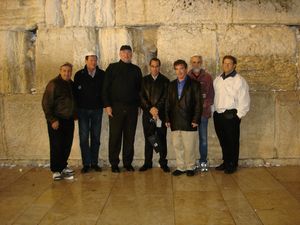
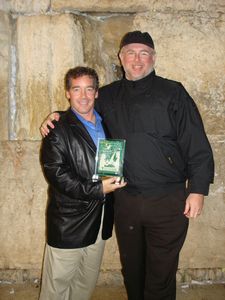
We went into the Old City in Jerusalem and to the kotel (Western
Wall). I had always thought the kotel was the western wall of the
second temple itself, but I learned that it was the western retaining
wall that supported the mound upon which the temple stood.
At the wall, Bob was given an award by Jon and ATS.
After dinner at the Taverna restaurant, we walked around the Jewish
and Armenian quarters of the Old City. We climbed to the rooftop at
the nexus of the Armenian, Christian, Jewish, and Moslem quarters. The
view was spectacular. Architecture in each quarter is somewhat
different, and roof tops are a key to identification. Similarly, Arab
developments are more organic than Jewish areas which tend to be more
planned. As we looked out on Jerusalem, we hummed and sang along with
Gilad as he led us in singing Yerushalayim Shel Zahav
(Jerusalem of Gold, a very famous song). We ended our first very full
day in high place, on a high note, all getting pretty high on the
experience.
Tuesday, 8 November 2005
Breakfast Tuesday was a bit earlier at 7:00. Monday was so packed
with activity that it seemed that more than one day had elapsed. We
braced for another busy day with another unbeatable breakfast as we
checked out of the hotel and drove out of Jerusalem.
We saw "the fence," a barrier Israel is constructing to limit the
motion of terrorists. Much more than a simple fence, the barrier is
typically a hundred meters wide including a fence or wall, monitoring
equipment, ditches, dirt swaths that show tracks, service roads, and
more. Since erecting the fence around Gaza, terrorist attacks from
Gaza have been essentially eliminated, which is viewed as strong
evidence for the effectiveness of the barrier.
Of course, the fence forms a de-facto border, which is a political
hot potato.
Mid-day we learned that we had scored a meeting with Bibi
Netanyahu, so we ended updriving back to Jerusalem and grabbing some
falafel and swarma in the German Colony. Noone ate at the McDonalds
next door even though they offered McSwarma. A few hours extra driving
was worth the meeting.
We visited Israel Aircraft Industries (IAI), a government owned
corporation, the largest exporter in Israel with about 15,000
employees. Barry Schlossberg, from the commercial group made a
presentation and took us to see a couple of production lines.
IAI is currently ramping up. A new model of the business jet is
coming into production. IAI will be making 40 Gulfstreams a year; they
have been making 20 a year. Also, IAI is a second tier contractor on
the 787 (a composite material plane) producing the door surrounds and
floors. 787 program ramping up, worth $50M/year to AIA.
IAI has a big program in converting passenger planes to
freight. Freight planes fly once a day and make much more money than
commercial planes.
We toured the military fighter plane upgrade line: A4, MIG 21,
K'fir. We then toured the Galaxy (commercial) assembly line including
the Gulfstream 200 executive jet. They showed us a high tech new
positioning tool that saves production time.
The influx of Russian immigrants brought an ex-General to Leshem's
team. Using his connections, he was able to buy a surplus military
Russian radar system on the cheap ($10K), that was retrofitted to
track migrating birds. The general and the radar are shown here.
Leshem processes radar input every ten minutes, and passes the
information to the Israeli Airforce, which establishes no-fly
zones. Russian radar directs the paths of Israeli fighter jets to
avoid flapping birds.
Leshem's work in studying bird migration uses past observations as
well as current radar information to track migrating birds. As soon as
he began feeding information to the army, incidents at all levels
dropped 75%. This built a strong relationship with the military, and
Leshem suggested building an educational and research center at
Latrun, which would be good for everyone.

Leshem drives educational activities across cultural boundaries,
binding Israeli school children with Palestinian school children and
Jordanian school children through his project Migrating Birds Know No Boundaries.
The tracking work is being extended to other migrating mammals.
Technion Institute of Management
The Technion Institute for Management (TIM) was conceived and
initially funded by ATS folks in Boston, who felt that management
skills in Israeli industry could use additional training. They began raising money in
1986 ($40M target), and it took four years to get approval from
Technion. TIM is a professional program (not degree granting).
Lester Thurow, Dean Emeritus of MIT's Sloan School of Business, is the chair.
Everyone that works for TIM came from the business world. Our main
presenters were Yoram Yahav, the CEO, Thali Levy, in charge of
marketing and strategy, and Soshi Gal. They only train companies that
operate in Israel and do business internationally, bringing in teams
of five for seven months, three to four days a month. The program is
six or seven years old, and seems to have more demand than they can
accommodate.
There are now 39 management programs in Israel. Another one was not
needed. All the programs are focussed around the manager, not the
change agent. The visionary creates chaos, the manager's job is to
make sense of the chaos. TIM focusses on the overlap.
TIM's staff of 16 and 45 others have trained 1099 people so far
(50% of the graduates have MBAs and PhDs). They started with a
senior management program, and now also run programs for single
companies.
Where are they going in the next two to three years? More in house
programs, around the world. Currently only Israeli based companies,
this may branch out.
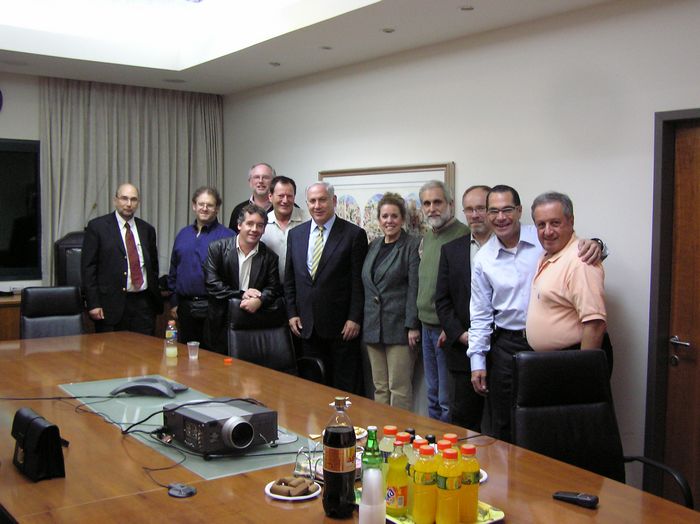 We had an opportunity to meet with Benjamin Netanyahu, former Prime
Minister, and recent Minister of Finance. Netanyahu went to MIT as an
undergraduate (Bachelor Of Science in Architecture, 1975) and to MIT's
Sloan School of Management (Master Of Science, 1976) where he studied
with Jon's friend Oded Levinger, who arranged our meeting. We met for
about an hour and forty minutes at Netanyahu's office.
We had an opportunity to meet with Benjamin Netanyahu, former Prime
Minister, and recent Minister of Finance. Netanyahu went to MIT as an
undergraduate (Bachelor Of Science in Architecture, 1975) and to MIT's
Sloan School of Management (Master Of Science, 1976) where he studied
with Jon's friend Oded Levinger, who arranged our meeting. We met for
about an hour and forty minutes at Netanyahu's office.
Netanyahu spoke clearly and eloquently. The group was not in
general deeply familiar with Israeli politics and economics, so it was
a bit like telling a bunch of business people that business principles
are a good idea - not a very hard sell. None the less, an
impressive performance.
A self described extreme capitalist, Netanyahu described Israel's
economic development and his recent role. Israel is a top producer of
conceptual products, as measured in US patents per year, certainly in
per capita terms, and even in absolute terms. The per capita income is
about $17K/capita, half of the US.
Israel was described in relationship to fast growing economies such
as Ireland and Cypress. Why has Ireland zoomed past Israel, and how has
Cypress pulled even (poised to pass)? Why is China growing? The free
market eliminates barriers to competition. Israel's GDP was shrinking
1% in absolute terms (more in relative terms) for the years before
Netanyahu was Prime minister (2001 and 2002), which some blamed on the
stock market crash and the antifadah. Yet during his administration,
the economy grew.
Netanyahu described a drill the army puts it's recruits through
called the elephant race. Everyone lines up, and every other person
caries the next one in a race. Some are similar sized; some being
carried are smaller, and some being carried are larger. Little
carrying big has no chance against big carrying little. This
is Netanyahu's analogy for the economy. The private sector supports
the public sector. In Israel, the public sector had grown
large. Netanyahu, as the Minister of Finance, found Israel close to
collapse (Brazil). He severely cut public spending by cutting wages to
public employees and severely cutting welfare. He also cut taxes.
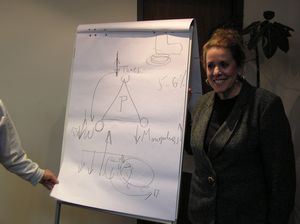 Netanyahu drew a "poverty triangle" labeling the bottom left
welfare, the bottom right monopolies, and the top taxes. Between 1992
and 1994, the population of Israel grew forty percent, mainly due to
Russian immigration. During the same period however, welfare grew
at fifteen times the population growth. There was widespread
abuse of the system. As the cost of welfare rose, taxes rose to
support the system. At the same time, monopolistic labor practices (ie
unions) conducted a record number of strikes, making the economy very
inefficient and making Israel an unreliable partner for
business. Netanyahu was faced with a four month strike in the ports,
and he won.
Netanyahu drew a "poverty triangle" labeling the bottom left
welfare, the bottom right monopolies, and the top taxes. Between 1992
and 1994, the population of Israel grew forty percent, mainly due to
Russian immigration. During the same period however, welfare grew
at fifteen times the population growth. There was widespread
abuse of the system. As the cost of welfare rose, taxes rose to
support the system. At the same time, monopolistic labor practices (ie
unions) conducted a record number of strikes, making the economy very
inefficient and making Israel an unreliable partner for
business. Netanyahu was faced with a four month strike in the ports,
and he won.
Netanyahu addressed what he considered to be the most hemmoraging
part of the welfare problem by privatizing the pension funds and
increasing the retirement age. He is privatizing the economy, and the
economy is growing, now at 5.5%, the fastest growing economy of any
nation over $10K/capita income. Netanyahu's goal is to pass all Western
European countries in per capita income in the next ten years,
reaching number one in the world in fifteen years.
Netanyahu is not a shy man. He described how predictions in his two
books have come true (eg, terrorists attacking the World Trade
Center). What will your next book be about? Probably the fat man and
thin man analogy.
If the fat man cuts too many calories, he can get sick, no? You
need to pump money back in where it is needed, for example, to support
the elderly. But, if you can work, you must work. Also, education
cannot be average costed. An engineering education costs more than
Tibetian poetry. The academic union (tenure) must be broken.
Greenspan looks at two things:
1) Is the stock market rising? and
2) Are long term government bond rates falling?
Both of these are true in Israel. The Bank of Israel interest rate
is now lower than the Fed.
Netanyahu then made three observations.
- Growth is dependent on reforms.
- Market economies without technology can grow.
- Market economies with technology are unbeatable.
What can the US do? Cut government (and taxes) by outsourcing
government (privatization). Healthcare is the hardest; Netanyahu knows
of no successful model to imitate.
Netanyahu established forty reforms, and would enact forty more
starting with land reform: privatize land ownership. Ninety three
percent of Israeli land is owned by the government.
We arrived in Haifa and checked into the Dan Carmel Hotel rather
late (after 11), another packed day.
Technion: Nano Technology
 Professor
Emil Zolotoyabko, Dean of the Department of
Materials Engineering gave us an intro to the nano technology at
Technion. Nano-technology research has sixteen faculty members, eight
senior research staff, fourteen research assistants, with sixty in
all. Two degrees are available: materials/physics and
materials/chemistry (both double degrees). There are 300 students
majors, and they service another 600 students.
Professor
Emil Zolotoyabko, Dean of the Department of
Materials Engineering gave us an intro to the nano technology at
Technion. Nano-technology research has sixteen faculty members, eight
senior research staff, fourteen research assistants, with sixty in
all. Two degrees are available: materials/physics and
materials/chemistry (both double degrees). There are 300 students
majors, and they service another 600 students.
Professor Zolotoyabko stands in the middle of the group, and our
morning undergrad tour guide Miriam is on the left.
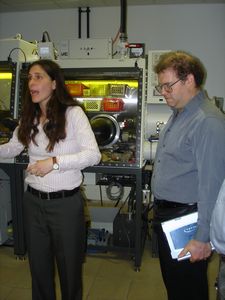
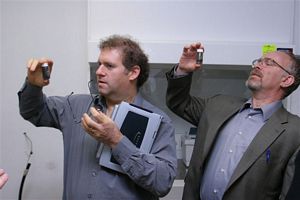 Dr.
Gitti Frey, a Weitzman grad, post docced in Cambridge. She runs
the largest nano lab at Technion. She explained that at nano scale
(10E-9 meters) structures are formed in materials. Atoms are 100 times
smaller, but organize at nano scale. Gitti works on how nano
structures control emitting light. The wetting or runoff of water on a
flower leaf is controlled at the nano scale. A synthetic chemist, she
said that she plays with Lego all day.
Dr.
Gitti Frey, a Weitzman grad, post docced in Cambridge. She runs
the largest nano lab at Technion. She explained that at nano scale
(10E-9 meters) structures are formed in materials. Atoms are 100 times
smaller, but organize at nano scale. Gitti works on how nano
structures control emitting light. The wetting or runoff of water on a
flower leaf is controlled at the nano scale. A synthetic chemist, she
said that she plays with Lego all day.
Steve and Leonid are enjoying Gitti's "Lego" demo: a nano thin-film
climbing the walls of the container.
We met with another professor with a nano lab using
lasers to form a galvanametric mirror to measure the curvature of the
surface before and after the deposition of thin films in the
fabrication process. Also he measures distortion during heating and
cooling cycles and studies process improvements that mitigate
distortion. Process improvements allow elevated temperature operation,
decreasing the need for cooling.
Technion: Center for Pre-University Education (PUC)
Prof. Menahem Kaftory, the head, and Mr. Shmuel Dotan, the
Director, described the prep program. At Technion, all classes are in
Hebrew. Technion assists the transition from the army as well as for
students from outlying areas and immigrants. There is an Ulpan
(intense Hebrew training) for a six months, and then few weeks
additional Hebrew training before the prep courses.
We heard from four PUC and one other student.
- Nadia arrived from Moldovia and made aliyah a year ago. After
about a half a year of Hebrew study, she was accepted to Technion. The
prep month (at Technion) concentrated on technical terminology. Nadia
had never studied physics and math so seriously. The university did
not accept course work from her Moldavian University as it was not
listed in some standard book. Twenty-one years old, Nadia is in Israel
by herself.
- Nachum is from Bet Shiran (a poor area) he reported as having weak
schooling. Nachum got involved with (kids) scouting. After he joined
the army, he wanted to study, but his grades were not adequate for
admission to Technion, so joined Mechina, the prep program. Nachum's
parents were born in Israel; his mother's side goes back six
generations locally, and his, father's side is from Poland. He wants
to study CS.
- Magaset is Ethiopian, the oldest of three. Her mother, the
provider, works at an old age home and has weak finances. During the
last year of high school, Magaset focussed on academics, and her math
teacher talked about Technion, but it was financially beyond reach.
The army program gave her an opportunity to go to Technion. Magaset
grew up in Kiriay Ata (a suburb of Haifa). Her sister is in ninth
�grade and hopes to follow. Are your parents encouraging? They weren't
anxious for Magaset to leave home.
- Hamed (not in the prep program) grew up in the Golan Heights in a
Druse community. At 17, he went to Syria to study IT and worked two
months every summer; he worked hard for eighteen shekels a day (four
US dollars). He doesn't have a passport and is only allowed to cross
the border once a year. He studied Java, C C++ .NET C#. Even after
completing his studies, when he went to Israel, he got 540/800 in the
Israeli SAT and was disillusioned. He decided to start over and study
at Technion (his dream). But, with 540, there was no chance to get in
to Technion. You need about 500 to get into the prep program. Now he
studies four days at Technion, and then works one day (forty dollars).
Steve encouraged Hamad with a story about his dad, a holocaust
survivor, who started with nothing and bootstrapped himself through an
undergraduate education at Temple University. Even then, finding that
he did not have the skills he needed to succeed, he started over at
MIT as an undergrad. It worked.
Gilad helped us understand the Druse puzzle. The Druse are
culturally Arab. Hamad comes from a village in the Golan that was part
of Syria until 1967. It is conceivable that his village will go back
to the Arabs, and anyone who accepted Israeli citizenship may be
punished. As a result, some have no citizenship.
Gilad also explained a bit about secrecy in the Druse culture. Even
their own people are told the "secrets" of their culture slowly over
many years in an attempt to keep their society closed and their
secrets safe.
There is an enrichment program for Ethiopian kids, and the parents
participate for a day to help get their buy in to encourage their
kids. They look for kids in the sixth grade and try to build up their
opportunities and confidence.
The army supports these programs as long as students study areas
the army needs, especially science and engineering. In the sixth year
of the army program, Technion has 600 students, and the program has
1100 students across the country. The Atedim program is a full
ride. There is an application and interview process; one-third of the
applications are selected. You must have studied math, English, and
physics in high school.
The Army found that it was hard to attract enough smart people from
the cities, but they could find plenty of promising kids in poor rural
areas. By testing and offering early guidance and scholarships, they
both provide opportunities for kids that would be very unlikely to end
up at Technion, and they get excellent recruits. Promising kids are
brought into the program, but they have to prove themselves with test
results before they are awarded their scholarships.
The Jon and Melissa Hirschtick Software Technology Floor was
dedicated with appropriate fanfare. Professor Lavie aplolgized that
the President of Technion could not be present at the dedication. He
was in Malta at a conference of Arab and European University
presidents and Nobel Lauriates looking for ways to use science to move
toward peace. Jon gave a heart-felt speech about the importance of the
people over the bricks.
Yaron Valler, VP of Business Development
established 1991: fourteen zero-stage companies. They look for innovative
technologies.
Recently, a partnership between Technion and four VC funds: Vertex
Venture Capitol (access to Asian market), ProSeed Venture Capital
Fund, Shalom Equity Fund, Vitalife Partners
Selected as Israel's leading incubator by the office or the chief
scientist four of the last seven years; over $20M in incubator sales
in 2004. %50 in follow on investments.
64 startups: 30 completed incubator and continue, 25 closed
Last six investments:
- Matteris: holographic storage, 5TB on CD sized media, data
compression.
- DAR Engines: rotary ceramic internal combustion engine and micro CHP
(combined hidden power)
- CorrelSense: IT performance analysis and fault prediction based on
chaos
- Genegrafts: modulating excitable tissues - Parkinson's, epilepsy,
diabetes. They implant cells in the liver.
- Image In: rigid disposable endoscopes
- Regentis Biomaterials: urges cells to grow tissue (knee) bone, spine,
and cartilage repair
What were most common causes for failure? Key cause: not finding
the right people, not technology.
Technion: Dinner
We had dinner at the Dolphin restaurant in Haifa with Technion related guests:
Prof. Eddy Karnieli, Director, Institute Endocrinology,
Diabetes & Metabolism, Faculty of Medicine,
Mr. Benjamin Soffer,
Manager of the Technology Transfer Office, Mr. Arik Peretz, Executive Director &
Founder of the Technion Business Plan Competition BizTEC, Mr. Dan Grotsky
and Mr. Yaron Barac BizTEC.
Karnieli, who does diabetes research,
mentioned that technology for non-invasively measuring blood glucose
was being brought to market by several companies, including (I
believe) Medisense and Abbot. This will enable insulin pumps with
closed loop feedback, which is not currently possible. Currently
insulin pumps simply provide continuous delivery, but have no
feedback. He also mentioned a recent article in the New England
Journal of Medicine on testing glucose and measuring BMI.
We went to Tel Aviv to meet with Retired Major General Amos Horev. Jon described him as a "founder" of Israel, and that was not mere hype. We probably experienced one of the most special experiences. It lasted nearly two hours, and we hung on every word of the octogenarian who was born in Jerusalem in 1924 or so, fought in the War of Independence in 1948, was the head of the Israeli Defense Force's Weapons Development, led mobile artillery for the Sinai and 1967 Six Day Wars, was Chairman of the Board of Rafael, and was President of Technion University. And this is not a complete list of his accomplishments! It was unbelievable. The man is barely five feet tall today, but his wisdom was truly overpowering.
He spoke at length about the fight for independence and how Israel learned from that experience that "self reliance" was required if Israel was to survive. He had no college degree at that time but was able to retrofit junk machinery that Israel could get its hands on to make needed tanks and guns. He has great disdain for politics, noting that "politics is something horrible" and claims that politicians, not academicians, are the ones in an ivory tower. He stated that "excellence for Israel is a matter of existence". He believes that technology and science are Israel's life line and that unlike the reality of politics, technology and science mandate processes, investment and long range planning.
Amos received his formal education at MIT, a Bachelor's and a Master's in two years (both in 1952 in Mechanical Engineering - he failed to mention that he also went back to MIT for his Engineer's Degree in 1964 - amazing what is listed in alum records - I won't publish his home phone number :-). He talked of how amazing it is to see Israel today when he knew it over 50 yrs ago. He marvels over every aspect of Israeli development - even the fact that Hebrew - a biblical language - is now spoken by more people than people who speak Norwegian.
We talked about Israel's relationship with America. While he readily acknowledges that the U.S. is Israel's greatest ally, he worries about the day when its interests differ from those of Israel. And he believes that that day will come. Kissinger recently told Israel "don't get too used to America's economic aid". In fact, Amos claims that Israeli companies are often disadvantaged when competing with U.S. companies for sales to Europe because the U.S. pulls out the "we give you aid, so back off" card.
One of the most interesting things this wise and experienced man said had to do with the disengagement. He said (and this is a quote) "Ruling over people - even if they want it - is a corrupt policy". Amos so admired Sharon for the guts to disengage and in this respect compared his courage to that of Ben Gurion (though he thinks that Sharon is very flawed in other respects). According to Amos, Israel should unilaterally withdraw from the West Bank as well, but pursuant to Israel's desired borders (which means retaining the critically strategic land in the Jordan River valley that lies between the Palestinians and Jordan). In Amos' view, Israel will do better with in terms of borders if it unilaterally withdraws than it will with a negotiated withdrawal. It was so interesting.
The meeting with Amos ended when Steve began singing a Hebrew song he had learned as a child in a Jewish youth group. When Steve started singing, I was taken by surprise (to put it mildly), but within seconds, Amos grinned and robustly joined Steve in the song - which it turns out was the Israeli army's marching song during the 1948 War of Independence. Awesome moment!
On and Off the Bus
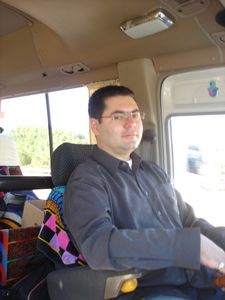
Moshe drove us from to Jerusalem, Haifa, Tel Aviv, back and forth, with knowledge and style. On the bus and off the bus we had many interesting discussions. There are still so many stories to tell.
I hope this section continues to collect stories - send your stories to Steve to have them included.
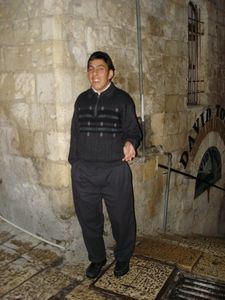 This fellow told us a joke in the old city.
This fellow told us a joke in the old city.
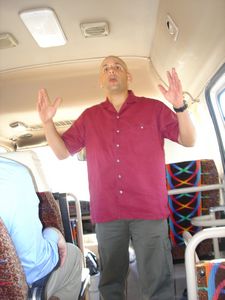
Tuesday afternoon: On the bus, Gilad, gave a terrific counterpoint to
Netanyahu. Israel was founded on socialist principles, and Netanayhu
is steering hard the other way. He cut welfare drastically, leaving
many more poor without state support. Gilad concedes that there was
abuse of welfare, but there are now hungry people. (There is no
homelessness in Israel.) Later in the trip a Technion student (Ruthy)
lamented the cut of a pension that had gone to Holocaust
survivors; the total cost is minimal as they don't have long to live.
Scott recalls walking with Gilad and talking about the Palestinians and how difficult it is for them to cross the checkpoints to work. It just so happened that there was trash out at the side of the road, and Gilad pointed out that there are plenty of Palestinians willing to do unpopular yet essential jobs such as garbage collection. Gilad asked, "How many Jews do you know who want to be garbagemen?" Point taken.
We saw a lot of planes. Probably after visiting IAI (on Tuesday), Joel told this joke: An
Israeli general went to the US to raise money for a new plane. He
appealed to the collected potential sponsors, "You must each give
twenty-five thousand dollars for this program." A man at the back of
the room called out, "It'll never fly!" The general ignored him and
focussed on the security needs of Israel, again appealing for support,
"You must each give twenty-five thousand dollars for this program."
The same follow called out again, "It'll never fly!" The general
addressed the fellow, "Are you some sort of MIT Aerospace PhD?" "No,"
he replied. "I'm a tailor. Let me tell you, with all the plaques
you're going to have to put on that plane, it'll never fly!
Late Wednesday night: On our last night in Haifa after visiting the B'Hai Temple, Gilad and Ken had a quarrel of sorts. Gilad advised us, as we were about to disembark the bus sometime after midnight (having begun the day at 7), that we were meeting for breakfast at 7 again. Ken, who was about to go to a business meeting and then to bed, quickly calculated that he'd have about four hrs sleep and presumably concluded that he'd be more tired with four hrs sleep than none. So he brilliantly and immediately suggested an override of Gilad's direction and shouted (those of you who were sleeping may not remember this), "No, let's meet at 4:30 a.m. so that we can see the sun rise before breakfast." Ken's nimble thinking and quick calculation of the benefits of sleep deprivation tickled Linda and provided one of the best laughs on the trip. Of course, laughing so hard woke Linda up, caused her adrenalin to keep her up on her blackberry for three hours, and resulted in her getting all of three hours sleep. But it was so worth it.
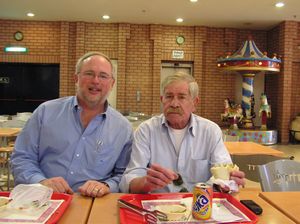
Thursday: We lunched with Jon's cousin who had been
conducting geneological research and had contacted Jon recently over
the internet. Cool. After lunch, Paul and Ken took their leave after eafter expressing their wonder about the experience and appreciation to Jon and the group. Paul headed off to meet his (grown up) daughter, and wondered how long it would take her to notice that he had changed.
Thursday: As the evening arrived, we visited the Tel (hill) at the old city of Jaffa. We shared words of appreciation as we wrapped our arms around each other's shoulders in a big group hug. We sang together: Hinay Ma-tov Umanayim (This is what is good (in life), being together as a family) & Oseh Shalom Bimramov (Peace, please!). That's the wrap. We felt like family (with each other and with the land), and we cried for peace.
Chaverim:
 On Sunday night, we went to dinner at the Olive & Fish in
Jerusalem. We met Isaac Cohen and his friend Perez, both Technion
grads and both formerly Rafael employees. Although Technion is
Israel's engineering and science powerhouse, Yeshiva U and Tel-Aviv U
were described as up and coming.
On Sunday night, we went to dinner at the Olive & Fish in
Jerusalem. We met Isaac Cohen and his friend Perez, both Technion
grads and both formerly Rafael employees. Although Technion is
Israel's engineering and science powerhouse, Yeshiva U and Tel-Aviv U
were described as up and coming.
